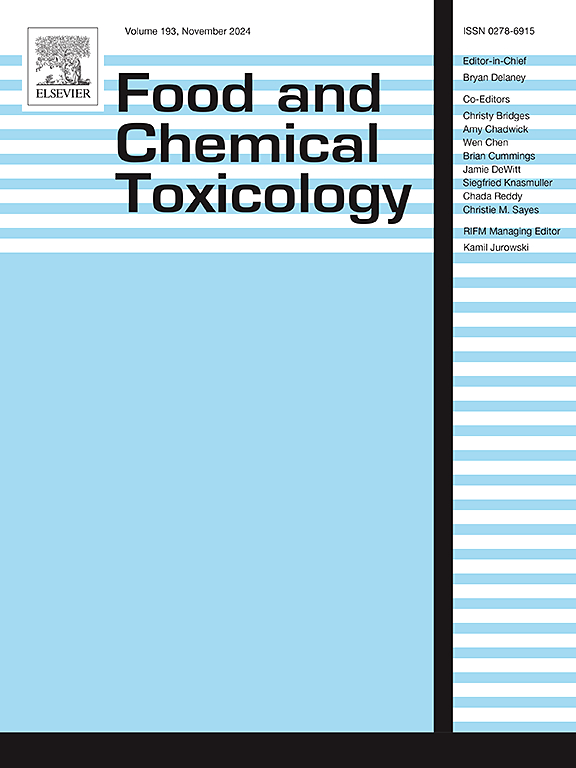Melatonin protects against cadmium-induced endoplasmic reticulum stress and ferroptosis through activating Nrf2/HO-1 signaling pathway in mice lung
IF 3.9
3区 医学
Q2 FOOD SCIENCE & TECHNOLOGY
引用次数: 0
Abstract
Cadmium (Cd) is a prevalent heavy metal pollutant known to cause lung damage. However, the mechanisms underlying Cd-induced lung injury and the associated therapeutic strategies remain unclear. By establishing Cd-induced lung damage models both in vivo and in vitro, we observed that Cd inhibited the Nrf2/HO-1 signaling pathway, disrupted the redox balance in lung tissue, accelerated endoplasmic reticulum (ER) stress, and promoted ferroptosis, ultimately leading to lung injury. Melatonin (Mel), a potent reactive oxygen species (ROS) inhibitor with high antioxidative efficacy, mitigated the increasing in ROS and the decreasing in superoxide dismutase levels induced by Cd, as well as the upregulation of PERK-eIF2α-ATF4 signaling associated with ER stress, through the activation of the Nrf2/HO-1 signaling pathway. Furthermore, Mel administration not only prevented Cd-induced iron overload but also reduced lipid peroxidation levels, thereby improving mitochondrial morphological alterations. Collectively, our results demonstrated that Mel treatment alleviated Cd-induced lung injury by inhibiting oxidative stress, which in turn ameliorated ER stress and ferroptosis through the activation of the Nrf2/HO-1 pathway.
镉(Cd)是一种普遍存在的重金属污染物,已知会造成肺损伤。然而,镉诱导肺损伤的机制及相关治疗策略仍不清楚。通过在体内和体外建立镉诱导的肺损伤模型,我们观察到镉抑制了Nrf2/HO-1信号通路,破坏了肺组织中的氧化还原平衡,加速了内质网(ER)应激,促进了铁变态反应,最终导致肺损伤。褪黑素(Melatonin,Mel)是一种强效活性氧(ROS)抑制剂,具有很高的抗氧化功效,它通过激活Nrf2/HO-1信号通路,缓解了镉诱导的ROS增加和超氧化物歧化酶水平下降,以及与ER应激相关的PERK-eIF2α-ATF4信号的上调。此外,服用 Mel 不仅能防止镉诱导的铁超载,还能降低脂质过氧化水平,从而改善线粒体形态学改变。总之,我们的研究结果表明,Mel治疗通过抑制氧化应激减轻了镉诱导的肺损伤,而氧化应激又通过激活Nrf2/HO-1通路改善了ER应激和铁变态反应。
本文章由计算机程序翻译,如有差异,请以英文原文为准。
求助全文
约1分钟内获得全文
求助全文
来源期刊

Food and Chemical Toxicology
工程技术-毒理学
CiteScore
10.90
自引率
4.70%
发文量
651
审稿时长
31 days
期刊介绍:
Food and Chemical Toxicology (FCT), an internationally renowned journal, that publishes original research articles and reviews on toxic effects, in animals and humans, of natural or synthetic chemicals occurring in the human environment with particular emphasis on food, drugs, and chemicals, including agricultural and industrial safety, and consumer product safety. Areas such as safety evaluation of novel foods and ingredients, biotechnologically-derived products, and nanomaterials are included in the scope of the journal. FCT also encourages submission of papers on inter-relationships between nutrition and toxicology and on in vitro techniques, particularly those fostering the 3 Rs.
The principal aim of the journal is to publish high impact, scholarly work and to serve as a multidisciplinary forum for research in toxicology. Papers submitted will be judged on the basis of scientific originality and contribution to the field, quality and subject matter. Studies should address at least one of the following:
-Adverse physiological/biochemical, or pathological changes induced by specific defined substances
-New techniques for assessing potential toxicity, including molecular biology
-Mechanisms underlying toxic phenomena
-Toxicological examinations of specific chemicals or consumer products, both those showing adverse effects and those demonstrating safety, that meet current standards of scientific acceptability.
Authors must clearly and briefly identify what novel toxic effect (s) or toxic mechanism (s) of the chemical are being reported and what their significance is in the abstract. Furthermore, sufficient doses should be included in order to provide information on NOAEL/LOAEL values.
 求助内容:
求助内容: 应助结果提醒方式:
应助结果提醒方式:


